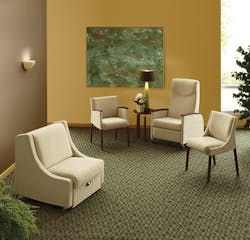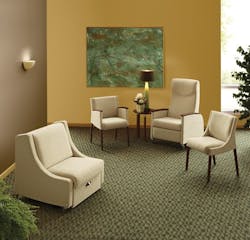Finding Healthcare Furniture that Works
By Maureen Orsborn
In a healthcare environment, there's more to guest and patient seating than meets the eye. The comfort and visual appeal of today's healthcare furniture belie its durability and functionality. Here, three healthcare furniture manufacturers share some insight on how to select the best furniture for your healthcare facility. Read on to find out what they prescribe.
Making a Great Impression
In today's healthcare industry, hospitals and clinics are marketing against each other much more competitively than in the past. Americans have become educated consumers when it comes to healthcare - they're interested in choosing which physicians they will see and, if necessary, which healthcare facilities they will check into. This competition has encouraged healthcare organizations to offer a patient experience that goes beyond traditional medicine. Stan Schneider, national sales manager at Grabill, IN-based Wieland, illustrates the importance of patient perception: "How does the patient feel after having been treated? Does he/she feel well cared for, was it a great experience, and so forth? A lot of the positive comments ... have little to do with the clinical outcomes of treatment."
Quality furniture will make a great impression on all who enter the facility. Furniture that is attractive and well maintained creates a warm environment that patients, visitors, and staff members can all enjoy. Amid reports of nursing and physician shortages, offering a comfortable work environment that will help attract and retain quality staff members is another way to gain that competitive edge.
Waiting Rooms and Lobbies
A strong design statement is a great way to convey your brand's message to the consumer, and the lobby is the perfect place to start. Debbie Breunig, vice president of healthcare marketing at Green Bay, WI-based KI Healthcare, describes the importance of lobby furniture: "You look at that as really your signature piece. [It] gives that first impression of the hospital - its brand, its image, what it stands for."
Look for lines of furniture that offer a variety of seating so your design statement can transition into other areas of the hospital. When selecting furniture for a waiting area, it's helpful to get specific about how the space will be used. A waiting room where patients wait to receive treatment will likely have a high turnover rate, so benches or tandem seating can help maximize capacity.
In larger waiting areas, the current trend is to fill the space with more freestanding seats and tables. This allows families to pull chairs together and to create a more intimate space when meeting with a doctor or the admitted patient. At times, guests might leave without returning the furniture to its original location, so bear in mind that reorganizing furniture could potentially create more work for staff.
Bariatric Furniture
To accommodate the growing bariatric population, healthcare furniture has changed in size and structure. Chairs come in a variety of seat widths, and weight capacities have increased. Facilities are finding that bariatric furniture is a necessity not just for patients receiving bariatric treatment, but also for an increasing percentage of the general population.
The idea is to make any special-needs furniture readily available, but not conspicuous. "Make sure you have a product that can meet the full range of your clientele's requirements," advises Jan Carlson, vice president of marketing, research, and product development at Grand Rapids, MI-based Nurture by Steelcase. "They're all in the same design language so that you can create a space that hangs together from a design standpoint and doesn't single out an individual population."
The Patient Room
You will find a variety of chairs, gliders, and recliners that assist in patient recovery. Manufacturers provide products that are comfortable and supportive for patients who will be sitting for an extended period of time. Look for chairs with high seats for patients with hip problems; chairs with raised, reinforced arms work well for patients who have trouble rising from the chair. Furniture that facilitates ingress and egress is helpful to the patient and the assisting staff member. To further reduce staff workload, choose guest furniture that is easily moveable or storable within the room.
As healthcare evolves, providers are becoming more aware of how important it is to involve family in a patient's care. Sleepover furniture for the patient room is quickly gaining popularity: Recliners and sofas unfold into sleep surfaces. If room space is very limited, customized products are available for installation.
Look for intuitive sleepover products that guests can operate without the aid of staff members. Even better, provide storage for pillows and blankets in the room or look for products that can hold bedding. Breunig explains: "That, in turn, brings much more efficiency to the caregiving staff because it eliminates the need for them to have to bring those things in for the family members, and it also helps the family member maintain that sense of autonomy. He/she can maintain his/her space and take care of him/herself without always having to go out and ask for pillows and blankets."
Upholstery and Cleaning
To keep furniture looking good over the long term, it is important to select upholstery that will stand up to 24-hours-per-day use and frequent cleaning. Look for high-performance textiles that resist stains, moisture, and bacteria. Upholstery that is soft and breathable (but with woven barriers that prevent fluids from penetrating the fabric) is beneficial. Also, look for treatments that can be applied to fabric to create a protective barrier without sacrificing the feel of the fabric. Before you make your final selection, make sure the upholstery is compatible with your cleaning methods. Some fabrics should be cleaned with a soap and water solution or a product-specific cleanser, so find out ahead of time how you will need to adjust your housekeeping procedures.
In clinical settings such as patient rooms and treatment centers, fluid and bacteria resistance is of the utmost importance. Carlson says, "There's a big immune system concern. The whole infection control and cleanability issue, I think, is escalated in those environments, both for the facility and for the patient to feel comfortable." For example, you might select furniture that also contains a fluid barrier over the foam cushion. The barrier prevents any fluid from reaching the foam and provides the added benefit of protecting the foam's urethane surface from being worn by the upholstery. Another type of upholstery product to check out is one that can be applied to textiles; its moisture barrier can ensure that water will not penetrate the cushion during cleaning.
Some current trends in upholstery are the use of bold colors and a wider variety of textures. Many designers will select furniture with fabric upholstery because of its residential feel, but that doesn't mean that vinyl is a thing of the past: It's durable, cleanable, and can be easily integrated with the design scheme.
Making Your Investment Last
Renewable components can greatly extend the life-cycle of a piece of furniture, so renewable furniture will not only reduce waste, but will also benefit your bottom line. "Product will simply, over time, get worn and damaged, and the things that most commonly are worn and damaged are the upholstery and where your arms or hands would rest," explains Schneider. He continues, "What we feel facilities should look for are products where those components or pieces, if damaged, can be replaced easily." Find out whether a broken component can be replaced on-site without drilling or creating a mess. Will facilities staff be able to repair damaged furniture; if not, what kind of assistance will the manufacturer provide?
Furniture that can be reconfigured will also minimize waste. Rob Way, vice president of product development for Grand Rapids, MI-based Nurture by Steelcase, explains that, as a hospital transitions through its 5- to 6-year development plan, a clinical area, for example, may move from its original location to a different space. He says, "It's very important to be able to take and reconfigure seating and add seats or take seats off and change it around."
Manufacturers stress the importance of purchasing furniture from a company that is focused on meeting the special needs of the healthcare environment. Lobby furniture that sees an 8-hour day in a commercial environment won't hold up to the rigors of the 24/7 hospital environment. Manufacturers currently follow BIFMA (Business and Institutional Furniture Manufacturer's Association) Intl. standards as a guideline for testing healthcare furniture, but these standards do not cover all healthcare applications. There are no guidelines for testing bariatric furniture, for example, so manufacturers devise their own testing methods. Ask the manufacturer about the additional testing that a product has gone through to determine its safety.
Healthcare manufacturers have the furniture solution for your facility, but don't just take their word for it. Ask about it. " ... Talk to somebody else who has actually used the product," says Way.
Maureen Orsborn is a contributing editor at Buildings magazine.

